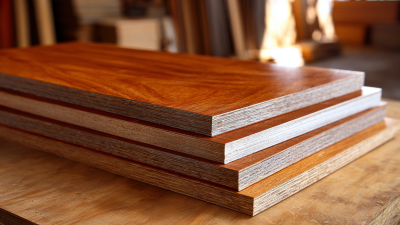Leave Your Message
As the demand for sustainable building materials continues to rise, alternative wood has emerged as a pivotal solution for eco-friendly living. According to a report by the Forest Stewardship Council, approximately 30% of wood harvested globally is unsustainable, leading to deforestation and environmental degradation. In contrast, alternative wood options—such as bamboo, reclaimed wood, and composite materials—offer a more sustainable choice that can significantly reduce carbon footprints. The World Wildlife Fund notes that using sustainable wood products can lower greenhouse gas emissions by up to 50%. This shift not only benefits the environment but also supports a growing market for eco-friendly products, with sales projected to reach $1 trillion by 2025. By exploring the benefits of alternative wood, consumers and builders alike can contribute to a healthier planet while enjoying the unique aesthetic and durability these materials provide.

As the world increasingly recognizes the importance of sustainable living, alternative wood options have emerged as viable solutions for eco-friendly practices. By exploring materials such as bamboo, reclaimed wood, and composite options, homeowners can significantly reduce their environmental impact. Not only do these materials offer durability and , but they also help conserve natural resources, making them an attractive choice for both builders and consumers.

Bamboo is rapidly gaining recognition as a leading alternative wood material, primarily due to its sustainability and versatility. Unlike traditional hardwoods, bamboo is a grass that grows at an astonishing rate, reaching maturity in just three to five years. This fast growth cycle allows for a more sustainable harvesting process, significantly reducing deforestation and promoting ecological balance. By choosing bamboo over conventional wood, consumers can contribute to a healthier planet while still enjoying the durability and aesthetic appeal that wood products offer.
In addition to its rapid growth, bamboo boasts exceptional strength and resilience, making it an ideal choice for a variety of applications, from flooring to furniture. Its natural antibacterial properties and resistance to moisture make it a practical option for households, especially in regions prone to humidity and pests. The use of bamboo not only provides an eco-friendly alternative but also supports local economies in regions where bamboo is cultivated. As awareness of environmental issues grows, utilizing bamboo as an alternative wood material stands out as a smart choice for those committed to an eco-friendly lifestyle.

Reclaimed wood has emerged as a popular choice for eco-conscious consumers looking to enhance their living spaces while maintaining a commitment to sustainability. According to a study by the Forest Stewardship Council, using reclaimed wood can reduce the demand for newly harvested timber, effectively preserving forests and minimizing habitat destruction. This sustainable option not only diverts waste from landfills but also often results in unique, character-rich materials that add charm to any home.
When considering reclaimed wood, it’s essential to ensure that the source is reputable. Buyers should look for certifications or documentation that guarantee the wood is genuinely reclaimed and responsibly sourced. Additionally, consider the treatment of the wood — it is often less hazardous than new materials, as reclaimed options may not have been exposed to the same chemicals or preservatives used in contemporary wood products.
**Tips:** Before purchasing reclaimed wood, research the supplier’s practices to ensure transparency in sourcing. Also, explore local options; opting for locally sourced reclaimed wood not only reduces carbon footprints associated with transportation but also supports regional economies.
| Aspect | Reclaimed Wood | New Wood |
|---|---|---|
| Sustainability | High - repurposed from old structures | Variable - depends on sourcing |
| Carbon Footprint | Low - minimal new production | Higher - involves logging and processing |
| Aesthetics | Unique character and history | Uniform and commercial feel |
| Durability | Often stronger due to age | Depends on species and treatment |
| Cost | Can be higher due to sourcing | Typically lower for mass production |
| Environmental Impact | Minimal - reduces landfill waste | Potentially damaging - impacts forests |
Cork has emerged as a leading material in
sustainable home design, offering a multitude of ecological benefits. Sourced from
the bark of cork oak trees, this renewable resource is harvested without harming the tree,
allowing it to continue growing and absorbing carbon dioxide over its lifetime. This process
not only supports biodiversity but also contributes to carbon sequestration,
making cork an environmentally friendly choice for eco-conscious homeowners.
In addition to its sustainability credentials, cork boasts impressive functional properties.
It is naturally resistant to moisture, mold, and pests, making it an ideal option for flooring,
wall coverings, and insulation. Cork's unique cellular structure provides excellent
thermal insulation, helping to maintain comfortable indoor temperatures while reducing energy
consumption. Moreover, its inherent cushioning properties enhance comfort underfoot, providing
a warm and inviting ambiance in living spaces. As homeowners increasingly seek alternatives to
traditional building materials, cork stands out as a versatile and sustainable option that aligns
beautifully with eco-friendly living principles.
When selecting alternative wood products, it’s essential to consider sustainability and durability. Look for materials certified by organizations such as the Forest Stewardship Council (FSC) or similar bodies that ensure responsible sourcing.
Bamboo and reclaimed wood are prime examples of eco-friendly options, as they not only reduce waste but also minimize the impact on forests. Additionally, pay attention to the manufacturing process; products made with non-toxic adhesives and finishes are preferable for healthier indoor air quality.
Maintaining alternative wood products requires a different approach than traditional wood. Regular cleaning with mild, eco-friendly solutions can help preserve the integrity of the material without introducing harmful chemicals. For woods like bamboo, occasional oiling can enhance durability and appearance. Protecting surfaces with coasters and minimizing direct sunlight exposure can also prevent fading and warping. By following these tips, you can enjoy the beauty and sustainability of alternative wood while ensuring its longevity in your eco-friendly home.







